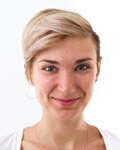|
|
BMe Research Grant |
|
Doctoral School of Architecture
BME Faculty of Architecture, Department of Explorative Architecture
Supervisor: Dr. Vasáros Zsolt
Zero Waste Campus
Establishment of a Plastic Recycling Lab at the BME Campus
The base of my research was the open-source website of Precious Plastic Movement, which I used for a studio project in 2020 to create a plan for a recycling lab at our University. This lab would enable the students and teachers to reuse their own plastic waste and create something valuable from it in a community-based environment. This lab, according to Precious Plastic, needs little resources, a few machines only to start local recycling. This Lab could alloy the knowledge of many of our Faculties at BME, by combining the clues of engineers to improve the machines, the capabilities of chemists and polymer specialists to study the materials and their possibilities, and finally, the skills of architects and designers to create designs for models and new products that turn our waste into something valuable and beautiful.
Brief introduction of the research place
Part of my research took place at the BME Campus, where I could collaborate with the Laboratory of the Department of Polymer Engineering to create recycled plastic sheets which would later be used for facade covering in a current architectural project. This project is a design that originates from the Faculty of Architecture which is the home to my research and projects.
In parallel, through workshops and exhibitions supporting the ongoing urban development of the area, we started a collaboration with the government of the 8th district in Budapest. The idea of recycled urban furniture and facade got support from Rév8 and the so-called Ötletcsarnok competition.
History and context of the research
I first met the work of Precious Plastic Movement in 2016, with recycled plastic as a design and architectural element, which inspired me to use these products as part of my design project in the 2017/18 academic year. Using PP’s open-source materials I designed a community kitchen and incubator house covered with recycled plastic tiles and used these elements as furniture in its interiors.
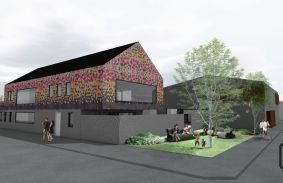
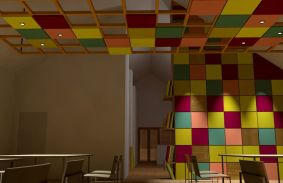

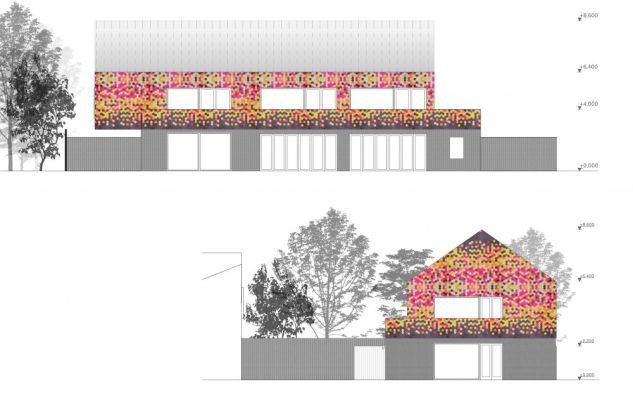
After that, in 2020 I joined the Budapest UP! course where I presented my idea of a recycling lab with success. The basis of this idea was the intellectual concentration of our campus, which we seldom use for collaborations – which I believe is a waste. The system used by Precious Plastic is based on the same professions that already exist at BME, so it seemed logical to use their idea to create a more sustainable and circular University campus. The project ended in group work where we created a small portfolio for the Lab.



But I didn’t want to end this project there, so in my doctoral research, I proposed that the continuation of this project be my main focus. As part of my research this year I managed to organize several events based on local plastic recycling at our campus and in the 8th district. Also, in collaboration with the Department of Polymer Engineering and the “Malom Project” studio, we organized a “nano-exhibition” at the Allee shopping center.
The research goals, open questions
My research has three main objectives. First of all, the creation of a community recycling lab, which I believe would be a huge step forward in the life of our campus. This requires a stable community that runs the sorting, cleaning, design, and machines, but involves all the students and teachers working at BME to participate in the selected collection of plastics. In this way, the lab would have an educational role at the same time. It could also be a potential location for workshops and visits to high-school students to get to learn about our University and local recycling and sustainability.
My second objective is to integrate sustainability and the circular economy into higher education at our institution. The result of this can be the support of related courses, research projects, and all these real projects and practical experiences.
And last, but not least, the project includes product development, currently urban furniture design and facades, but the design of small products by students who want to exhibit their creations can also be incorporated. My first idea was to make architectural models and industrial design projects using recycled plastic 3D prints, which is much less wasteful than using brand-new filaments for the printing process.
Methods
My research is based on both literature and experience. For my dissertation, I am looking for similar institutions and labs to learn about their methods that can be implemented in our case. To support my theoretical findings, I try to put these into practice and study the completed products and designs.
I would like to outline a system for the circulation lab that can operate permanently on the BME campus and can lead to further steps in the direction of sustainability. As part of this, I began to cooperate not only with other faculties but also with specialists in the market. This year we successfully joined forces with HWD Recycling Ltd, Malom Projects design studio, Precious Plastic Para-fitt, and Veroniq Engineering Group.
Based on our projects launched in 2022, I would like to create a research portfolio that documents all our current works and observations on the ZW Campus social media website and in publications.
Results
As mentioned above, this year I was involved in the organization of various workshops and exhibitions that brought people closer to this rather strange material and allowed locals to participate in community design.

One of the main projects is the construction of Budapest’s first building with a recycled plastic facade on Déri Miksa Street in the 8th district this summer for the Gardener House designed by György Alföldi, Olívia Kurucz, and Imre Bokányi. We would also place urban furniture on the side of this building and nearby public spaces using a mix of concrete and plastic waste, a material composed by the HWD Recycling team. These will be our first test products and hopefully the beginning of many other similar design projects.
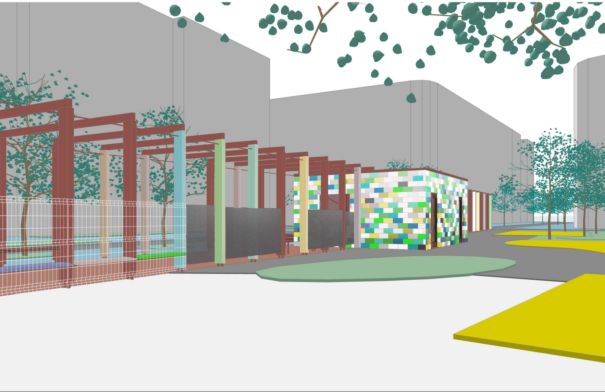
In June 2022, we started the production of these tiles in the Laboratory of the Department of Polymer Engineering. These tiles will be built in during the end of the summer of 2022 and autumn through community work in the framework of a construction camp organized for students and locals.

The urban furniture collection is still under design as we are testing the possibilities of the plastic-infused concrete material at the Faculty of Architecture.
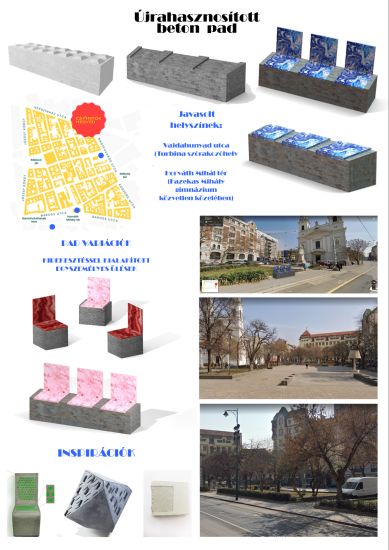
We also considered producing smaller design objects based on recycled materials.
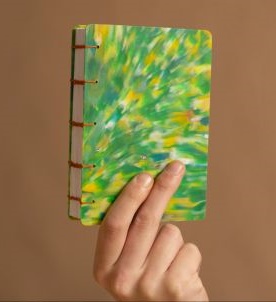
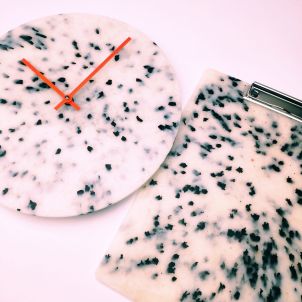
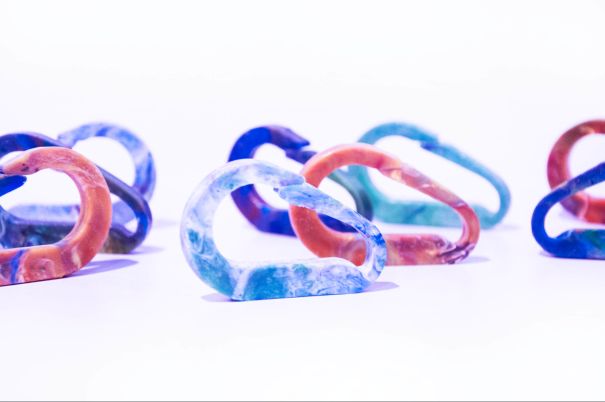
Expected impact and further research
I believe this topic is very important from an architectural point of view, as carbon emissions of the built environment account for 38% of our footprint, and of this 11% is created by new constructions. This is a fact that architects should be aware of when making a design choice.
This project aims to educate and raise awareness in addition to research-based designs. These goals were also incorporated together with the recycling lab idea into the 240th-anniversary sustainability goals of our institution.
On the 27th of July 2022, the jury of the DLA school accepted my proposal as the research topic of my subsequent two-year research at the complex exam, so I have the opportunity to further develop these ideas in the framework of doctoral education.
Finally, I would like to mention the 2022 ARCC-EAAE Conference that I attended this spring, where the research poster and my presentation were well received by the participants, which allowed me to collaborate with the research group of Florida International University’s recently established recycling lab. I hope that this connection between BME and FIU Universities will last.
Publications, references, links
ARCC-EAAE Miami Conference Presentation and Poster - 2022. - https://www.arcc-arch.org/2022-authors-of-papers-posters/
UF/Lab – Foodbank and Incubator House – 2016. - http://uflab.org.hu/portfolio/food-bank-and-incubator-house/
UF/Lab – Towards a Zero Waste Campus - 2022. - http://uflab.org.hu/portfolio/towards-a-zero-waste-campus/
Metszet journal - Interview with Bánáti and Hartvig Architecture Office about their sustainable office design and Sustainability in Architecture – 2022. to appear soon
